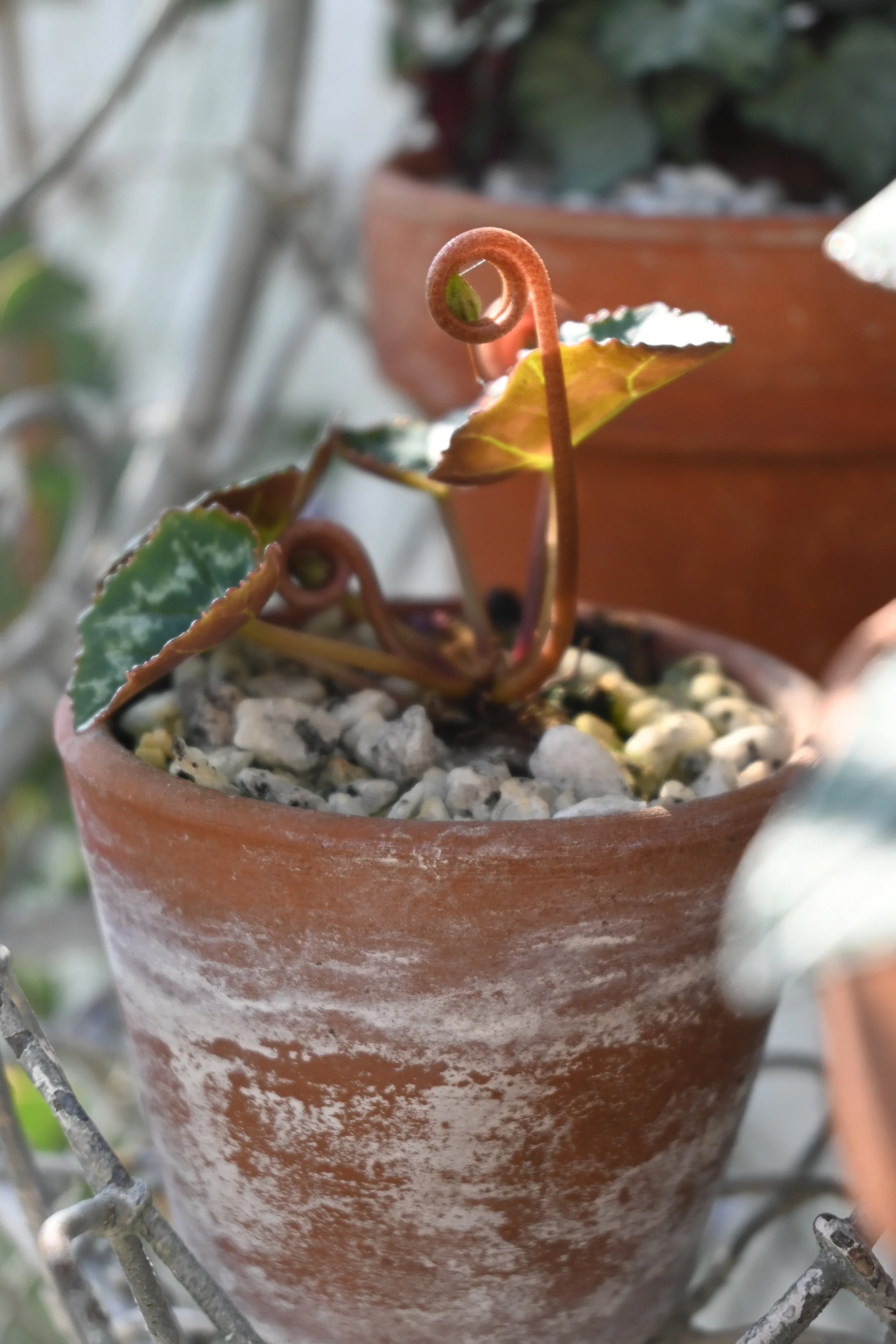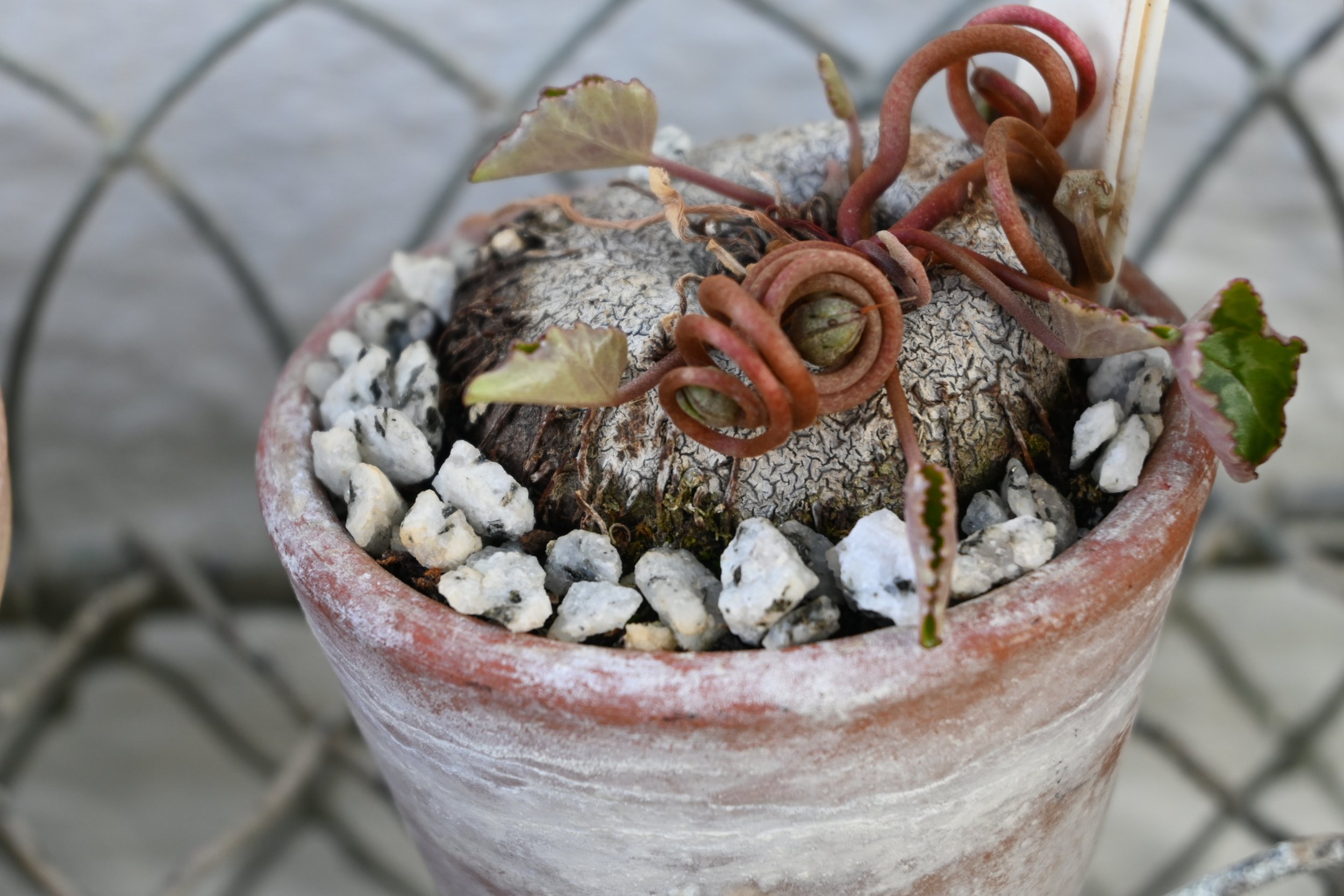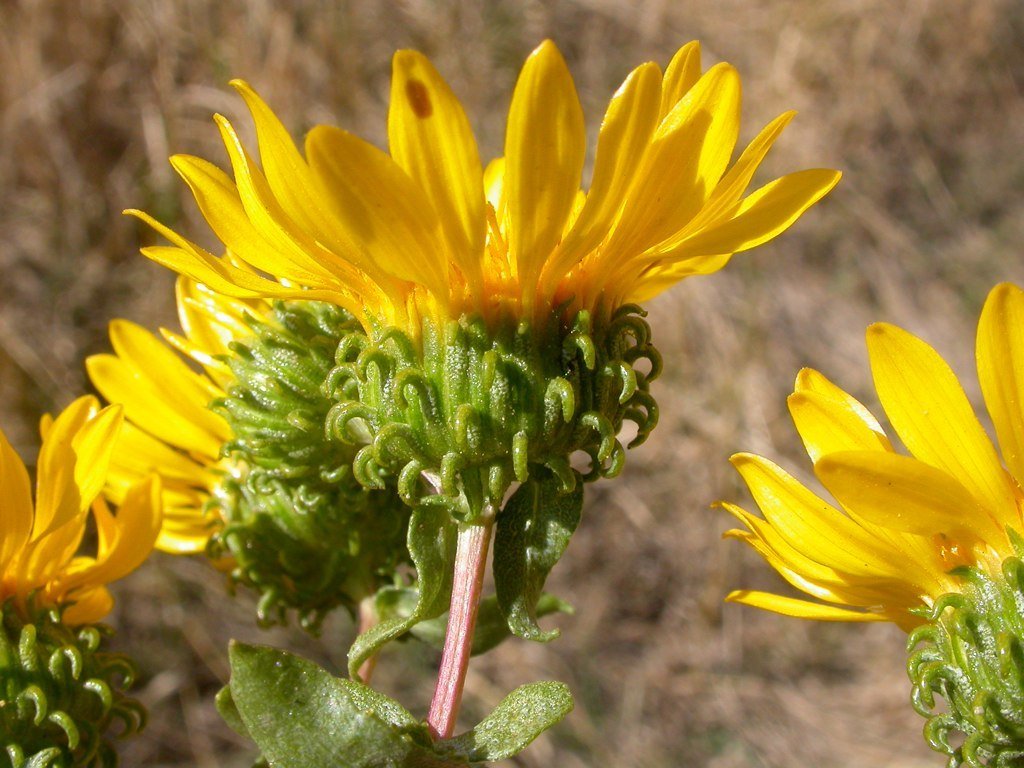Twisting, Turning, and Curvy Plants
Rachel Martin
The world of plants is a vast one. There are plants that can trap animals, flowers as large as your head, and plants that mimic insects. There are also an array of no-so-linear characters. Some might be obvious and have curved leaves or twisting branches; others are subtler, like wispy curves of a Clematis seed head, or the wavy margins of a leaf. Read on to learn more about all the bendy, curvy, snaking and twisting nature of plants.
Harry Lauder’s walking stick
Corylus avellana ‘Contorta’
Common names of plants will often be made up to try and reflect a relevant physical characteristic. Tuliptrees (Liriodendron tulipifera) refer to the distinct tulip-esque flowers, balloon flower (Platycodon grandiflorus) plays on the balloon shaped flower buds. In some cases, and to the chagrin of some, they can be complete wildcards. Scottishman Harry Lauder was a comedian and singer who gained major popularity in England before World War I. His comedic song styles were accompanied by dance numbers and costumes making him one of the most popular stage performers of his time. Due to his whimsical showmanship, often dancing with a gnarly walking stick, this name was attributed to him by Victorian gardener Canon Ellacombe who spotted the unusual contorted branch growing on a Corylus avellana in England. This branch sport was propagated and became a popular landscape plant for its winter and spring interest.
Winter flowers and branches of Corylus avellana ‘Contorta’. Image via Nurseries Caroliniana.
Female flowers of Corylus avellana. Image by Tom Molnar.
The species, Corylus avellana is a native of Western Asia, Europe, and North Africa and, unlike ‘Contorta’ doesn’t have winding limbs. It’s often found in sloped woodlands and along streams. In spring, male and female flowers appear before leafing out. The male flowers, which are referred to as catkins, dangle from the branches. The female flowers are more inconspicuous and bloom right above the catkins. When the leaves emerge they are wavy in nature with hairy texture and deep leaf venation. Fruits add another element to this plants the long list of interesting attributes. Hazelnuts (sometimes called cobnuts) are edible and ripen in the months of late summer and are used for everyone’s favorite hazelnut spread, which is now 77 years old. ‘Contorta’ is one cultivar that does not produce fruits but others like ‘McDonald’ and ‘Dorris’ are grown in Europe specifically for their higher nut yields.
Sand lily
Veltheimia capensis
The landscape of South Africa is rugged and diverse. In the central part of the country is the geologic formation known as the Great Escarpment, which extends north to surrounding countries like Namibia and Angola. By definition this escarpment drops off into the Cape Fold Belt as it moves south towards the coast. It is in this part of South Africa that the sand lily is found – more specifically, in the Western Cape. This area contains the fynbos biome which is a biologically diverse, fire-dependent shrubland and forest. Due to its location and geology, fynbos acts as a mountain catchment area and thus is extremely ecologically sensitive.
Image by Dick Daniels, CC BY-SA 3.0 via Wikimedia Commons.
In these areas are a smattering of bulbous plants, one of which is Veltheimia capensis. This isn’t your typical perennial bulb– the leaves are present through the winter and die back during spring and summer. And speaking of the leaves, they are muted blue-green with wavy and crisped margins that fold inward. The flowers point to it being a member of the Asparagus family (Asparagaceae), with tall spikes of speckled coral flowers appearing in late fall through winter. The tubular shape of the individual flowers are attractive to the country's Southern double-collared sunbirds.
A perfectly engineered rollercoaster loop. Image by Larry Allain, U.S. Geological Survey via USGS.
Toothache grass
Ctenium aromaticum
Ctenium aromaticum is a native perennial grass in the Poeaceae family. During the growing season, this grass doesn’t exhibit much of anything special and remains fairly nondescript until seeds are set. As the seeds begin to drop, the seed heads in turn begin to curl– the result is a curly-cue pig’s tail. This shape makes toothache grass stand out amongst its other neighbors in the wet savannas and longleaf pine ecosystems where it is found. Like with many in that ecosystem, flowering only really occurs after a fire disturbance. Broadly, this species is endemic to the Southeastern Coastal Plain and in the state of Virginia is critically imperiled.
While it’s not recommended, chewing the roots and stems will create a numbing sensation. The plant's foliage is aromatic, as referenced by the specific epithet aromaticum, and the genus Ctenium is Greek for comb.
Bone fish cactus
Selenicereus anthonyanus
Being quick on your feet is no easy feat for a plant. In fact, quick is extremely relative to rooted plants, or even epiphytic ones like this. It’s understood that at one point most of our North American cacti species had broad leaves but due to environmental changes, they shed them. For Selenicereus anthonyanus, which is native to Chiapas, Oaxaca, and Tabasco, leaves weren’t lost so much as changed. As the original arid climate of Central Mexico transitioned to tropical with more forested areas appearing, water resources became more readily available but sunlight became scarce. In response, the leaves transitioned to the funky zig-zagged flat pattern that makes this plant a unique stand out. Today in the lowland rainforests it climbs up trunks and branches to reach the light of the upper canopy.
Night owls and early birds can both rejoice in knowing this plant blooms at night and into the early hours of dawn. Whichever side you fall on, you’ll need to monitor it and note it in your date book since it only flowers once a year. The species is named after Harold E. Anthony, who was one of the first to observe this species in flower.
Honorable Mentions:
An honorable mention goes to Cyclamen, a species we’ve covered on our blog before. After the flowers are pollinated, their stems become perfect curly cues.
More understated but reflected in the common name, curlycup gumweed. This is a midwestern species in the sunflower family (Asteraceae) — the bracts on the cups that encase the flowers all curl downward.
References:
Ctenium aromaticum. Ctenium aromaticum - Coastal Plain Plants Wiki. (n.d.). Retrieved from http://coastalplainplants.org/wiki/index.php/Ctenium_aromaticum
Duncan, G. (2018, July). Veltheimia capensis. Veltheimia capensis | PlantZAfrica. Retrieved March 2023, from http://pza.sanbi.org/veltheimia-capensis
Manning, J. & Goldblatt, P. 2012. Plants of the Greater Cape Floristic Region 1: the Core Cape fl ora, Strelitzia 29. South African National Biodiversity Institute, Pretoria.
Muehlbauer, M., Capik, J., & Molnar, T. J. (n.d.). Choosing plants for a hazelnut orchard in New Jersey. E368: Choosing Plants for a Hazelnut Orchard in New Jersey (Rutgers NJAES). Retrieved March 2023, from https://njaes.rutgers.edu/e368/
Nursery, J. (2022, April 25). PLANT PROFILE: Contorted Filbert. JNI Knowledgebase. Retrieved March 2023, from https://kb.jniplants.com/contorted-filbert-corylus-avellana-contorta/
Prendusi, T. (n.d.). Plant of the Week. U.S. Forest Service. Retrieved March 2023, from https://www.fs.usda.gov/wildflowers/plant-of-the-week/grindelia_squarrosa.shtml
Sorrie, B. A. and A. S. Weakley 2001. Coastal Plain vascular plant endemics: Phytogeographic patterns. Castanea 66
South African National Biodiversity Institute (SANBI). Biomes of South Africa. South African National Biodiversity Institute (SANBI), 2006, doi:10.15493/DEA.CARBON.10000016.
University of Maine. (n.d.). Selenicereus anthonyanus - Roger Clapp Greenhouses & Littlefield Garden - University of Maine. Roger Clapp Greenhouses & Littlefield Garden. Retrieved March 2023, from https://umaine.edu/littlefieldgarden/home/plants-in-the-greenhouse/selenicereus-anthonyanus/
USGS. (n.d.). Ctenium aromaticum. Plants of Louisiana. Retrieved March 2023, from https://warcapps.usgs.gov/PlantID/Species/Details/1329
Weakley, A.S., and Southeastern Flora Team 2022. Flora of the southeastern United States. University of North Carolina Herbarium, North Carolina Botanical Garden.












